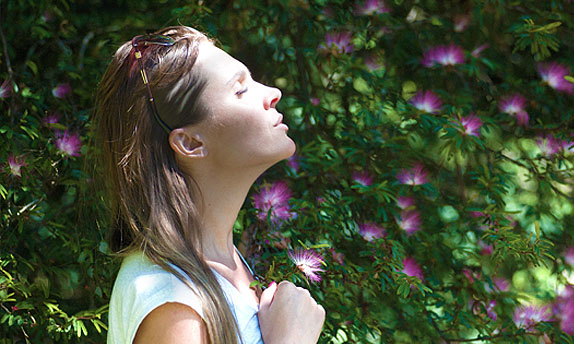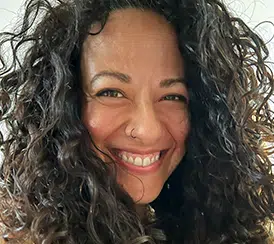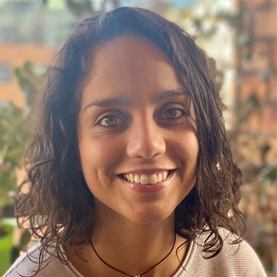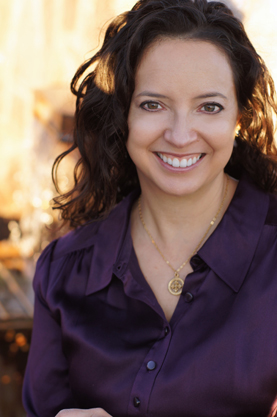
To develop the shaman’s sight we first need to learn how to engage our senses. When we engage the senses, we achieve a holistic perception of the world, so that touch, taste, hearing, and sight no longer separate us from experience, but make us one with what we perceive. You smell a fragrance and become the fragrance, indivisible from it. This is not a poetic kind of communion. It is a deep understanding of our interconnectedness. For example, when a medicine woman dips her cup into the headwaters of the Amazon, she doesn’t think, “Ah, now this water is mine.” Instead she observes, “Now the Amazon flows through me.”
To practice primary perception shamans have developed a kind of “common sense” that bridges all of the senses. They are able to taste fire, to touch the fragrance of a flower, and to smell an image. They attain immediate perception before an experience is divided among the senses, an ability known as synesthesia. Musicians, for example, often report hearing the air rushing past wing feathers as they observe birds in flight. This blending of sensory modalities seems strange only to those who have distanced themselves from a direct, primordial experience of the natural world. This “common sense,” which is the hallmark of primary perception, is an ability that most of us have lost with the rise of civilization. As the philosopher Maurice Merleau-Ponty wrote in Phenomenology of Perception, “Synesthetic perception is the rule, and we are unaware of it only because scientific knowledge shifts the center of gravity of experience, so that we have unlearned how to see, hear, and generally speaking, feel, in order to deduce, from our bodily organization, the world as the physicist conceives it, what we are to see, hear and feel.” Synesthesia grows as we bring awareness to touch, taste, sensation, and sound.
The following exercise will help you engage with your senses so you can move beyond the limitation of what your eyes can see, and begin developing primary and synesthetic perception.
Perceptual Exercise
Take your pulse, but do not look at your watch. Don’t count your heartbeat. Merely experience the tides that flow through you, the waves of lifeblood rushing within you. Feel the rhythm of your pulse. This is your tempo. No one else has a rhythm exactly like yours. Islanders in Indonesia believe that everything in life has a pulse. Thousands of years ago they cast bronze drums the size of an elephant and beat on them the rhythms of Creation to attune their spirit to the tempo of the Universe itself.
Use your imagination. What color is your blood? Are you sure it’s red? Why is it that your veins are blue? When does your blood change color? Why? Don’t think back to that biology class you had to take in high school. Your body knows the answer. Ask it. Follow your blood back to your heart and find the answer for yourself. The heart is the first organ to receive the red, oxygen-rich blood from the lungs, and it feeds itself first before pumping blood to feed the rest of the body.
Now bring your awareness to your breath. First cover one nostril and then the other. Which nostril are you breathing through? We breathe predominantly through one nostril for a few hours, and then the other. Follow your breath as it goes down your windpipe and into your lungs. What does it feel like? Does it sound raspy or smooth? Where did your breath come from, and how long is it yours?
Next engage your olfactory sense. What is your scent? Everyone has a unique scent. Smell your hand after you’ve chopped garlic or basil. Inhale many different scents: the sweet smell of flowers, the pungent smell of vinegar, the acrid smell of spoiled milk, the sweet scent of lavender. Most mammals rely first and foremost on their sense of smell. A polar bear is able to smell a seal thirty miles away. Monkeys sniff each other when they first meet. A lion in the bush will smell your fear.
After that, engage your sense of touch. The skin is the largest sensory organ in the body. It is fabricated from the same tissue as your brain and nervous system. Skin is alive. It erupts when it is angry, glows when it is pampered. Take a moment to caress your face. Feel your lips, passing your fingertips over their entire circumference. Caress the face of your beloved. Next, become aware of your feet. Wiggle your toes inside your shoes. The human brain works by inhibition. When you put on your shoes in the morning you are aware of the temperature and feel of the inside of your shoes. But then the brain inhibits this sensation, because, after all, you don’t want to have to be aware of your shoes all day. Only if you bump against a chair or step on a tack do you again become aware of your feet. Next time you sit down to eat a meal, switch the hand you use to hold the fork and knife. Notice how awkward it feels, and use this sensation to become aware of every bite you take and the flavor of your food.
Engage your sense of taste. What does your skin taste like? Lick your forearm. Is it salty or sweet? What does your blood taste like? Try it next time you cut yourself, and be aware of the taste. What does water taste like? It is commonly held that tap water is tasteless. This is not true. Water has its own taste, and the water in every city and stream tastes different. Drink slowly and savor it. Feel the coolness of the water and become that coolness; feel it suffusing the entirety of your mouth and from there radiating through your body. Allow the coolness to fill you.
Finally, close your eyes, take a deep breath, and listen. What are the sounds around you? Try to identify as many natural sounds as you can. Is there a bird singing? Are there bees humming? Are the sounds around you all man-made? Is there anything rumbling? Any high-pitched squeaks or cries? When tracking jaguars in the Amazon you listen to the birds. Their warning cries alert you to the whereabouts of the big cats long before their tracks are visible.
One of my favorite synesthesia exercises involves “tasting” your emotions. Become aware of the taste in your mouth. Is it sweet? Sour? Woody? Metallic? Now recall an incident that made you feel sad. Notice if the taste in your mouth changes. Recall a pleasurable situation, and notice again how the taste in your mouth changes. Now recall an instance where you felt fear. Can you savor the taste of fear? Of love? Of joy?
This is the first of eight exercises aimed at developing the shaman’s sight. Other exercises will be covered in future blogs.
.







